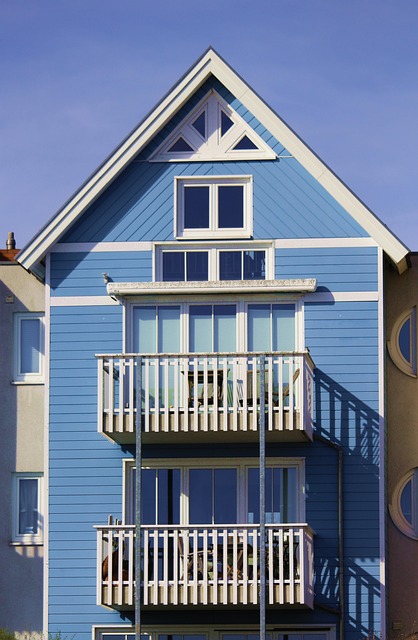Residential cool roof installations using single-ply membranes like TPO (Thermoplastic Polyolefin) and PVC (Polyvinyl Chloride) offer enhanced energy efficiency, durability, and cost savings. These materials provide excellent insulation, reflective surfaces for heat reduction, and watertight barriers against extreme weather. With proper preparation, installation, and maintenance, including regular inspection and repair, TPO and PVC membranes extend roof lifespans while promoting sustainability by mitigating the urban heat island effect and reducing greenhouse gas emissions. This guide outlines a step-by-step process for installing these materials, emphasizing crucial stages to ensure optimal performance in residential cool roof applications.
Integrating single-ply membranes like TPO and PVC is revolutionizing flat roof design, offering both durability and energy efficiency. This article delves into the world of these innovative materials, highlighting their benefits for residential cool roof installations. From understanding the fundamentals of TPO and PVC to choosing the right material and a detailed installation process, we provide a comprehensive guide. Furthermore, we explore maintenance tips to ensure longevity, making your flat roof a smart and sustainable investment.
Understanding Single-Ply Membranes: TPO and PVC for Flat Roofs
Single-ply membranes, such as TPO (Thermoplastic Polyolefin) and PVC (Polyvinyl Chloride), have gained significant popularity in residential cool roof installations due to their durability and cost-effectiveness. These lightweight materials offer a seamless, water-tight barrier when properly installed, making them ideal for flat roofs where traditional multi-ply systems may not be as efficient. TPO and PVC membranes are known for their exceptional heat-welded seams, ensuring strength and long-term performance even in extreme weather conditions.
For residential cool roof applications, TPO and PVC provide excellent insulation properties, helping to maintain comfortable indoor temperatures and reduce energy costs. Their reflective surfaces can also contribute to the overall energy efficiency of a building by reflecting sunlight away from the interior. With proper installation techniques, these single-ply membranes offer long lifespans, making them a sustainable choice for homeowners looking to enhance their roof’s performance and value.
Benefits of Residential Cool Roof Installation
Residential cool roof installations offer a range of benefits that extend beyond energy efficiency. By incorporating reflective materials and high-performance membranes like TPO (Thermoplastic Olifine Polyolefin) or PVC (Polyvinyl Chloride), homeowners can enjoy reduced indoor temperatures during hot summer months. This not only leads to lower cooling costs but also minimizes the strain on air conditioning units, extending their lifespan.
Moreover, cool roofs contribute to a more sustainable and environmentally friendly home. By reflecting sunlight and heat, these installations help to mitigate the urban heat island effect, decreasing the overall temperature of cities and reducing greenhouse gas emissions. Additionally, many cool roof systems are designed with durability in mind, ensuring long-lasting protection for residential flat roofs while promoting energy conservation.
Choosing the Right Material: TPO vs. PVC for Your Project
When selecting materials for a residential cool roof installation, understanding the nuances between TPO (Thermoplastic Olifin) and PVC (Polyvinyl Chloride) is essential. Both offer superior durability and water resistance, making them popular choices for flat roofs. However, they cater to slightly different needs.
TPO membranes are known for their exceptional heat-welded seams, providing a strong, continuous barrier against moisture intrusion. This makes TPO particularly well-suited for regions with extreme temperature fluctuations. On the other hand, PVC is lightweight and flexible, offering ease of installation and excellent resistance to chemicals and UV rays. For projects requiring a cost-effective solution without sacrificing performance, PVC stands out in the competitive landscape of flat roof materials, especially in residential cool roof installations aimed at enhancing energy efficiency.
Installation Process: Step-by-Step Guide for Flat Roofs
Installation Process: A Step-by-Step Guide for Flat Roofs with Single-Ply Membranes
The process of installing a single-ply membrane like TPO or PVC on a flat roof is both efficient and effective, making it a popular choice for residential cool roof installations. It involves several key steps to ensure longevity and optimal performance. First, prepare the roof deck by cleaning and inspecting it, ensuring there’s no damage or debris present. Then, apply a suitable underlayment to provide an extra layer of protection against moisture penetration.
Next, start at one edge of the roof and unroll the single-ply membrane, making sure it smoothly lays across the surface without wrinkles or overlaps. Secure the membrane using mechanical fasteners or adhesive according to manufacturer recommendations. As you work your way across the roof, regularly inspect for any tears or punctures and make repairs immediately. The final step involves trimming excess material and sealing any laps or edges to create a watertight seal and complete the residential cool roof installation.
Maintenance and Longevity: Ensuring a Durable and Energy-Efficient Roof
Single-ply membranes like TPO (Thermoplastic Olefin) and PVC (Polyvinyl Chloride) are renowned for their exceptional durability and low maintenance requirements, making them ideal choices for residential cool roof installations. These membranes offer long-term protection against leaks and weather damage, contributing to the overall longevity of the roof. Their seamless design minimizes potential entry points for water, further enhancing their resistance to moisture intrusion.
Regular maintenance plays a crucial role in maintaining the integrity and energy efficiency of these roofs. Simple tasks such as inspecting for any signs of damage or wear and promptly repairing them can significantly extend the lifespan of the membrane. Additionally, keeping the roof surface clean and free from debris ensures optimal performance of the reflective properties, which are key to achieving energy efficiency in a residential cool roof installation.
Integrating single-ply membranes like TPO and PVC for flat roofs offers a compelling blend of durability, energy efficiency, and cost-effectiveness, making it an excellent choice for residential cool roof installations. By understanding the benefits and nuances of each material, as outlined in this article, homeowners and professionals can make informed decisions to enhance roofing performance and contribute to sustainable living. The straightforward installation process, coupled with proper maintenance, ensures these membranes provide long-lasting protection, delivering both aesthetic appeal and substantial savings on energy costs.
